Photoresist & Photoresist Ancillaries Market by Photoresist Type (ArF Immersion, ArF Dry Film, KrF, G-line & I-line), Ancillary Type (Anti-reflective Coating, Remover, Developer), Application (Semiconductor & IC, LCD, ), Region - Global Forecast to 2028
Updated on : July 03, 2023
Photoresist Market
The global photoresist market is valued at USD 4.1 billion in 2023 and is projected to reach USD 5.3 billion by 2028, growing at a cagr 5.1% from 2023 to 2028. A photoresist is a light sensitive material composed of adhesive agents, sensitizers, and solvents. Adhesives are used to control the thermal property of the resist. The sensitizers define the photosensitivity of the resist, and solvents define the viscosity of the resist. A photoresist is mainly used in designing circuits. The process of using photoresist in designing circuits is known as photolithography, which is one of the patterning methods of semiconductor fabrication. The applications of photoresist and photoresist ancillaries are semiconductors & ICs, LCDs, PCBs, MEMs, and sensors. There are five main types of photoresists: ArF immersion, ArF dry, KrF, I-line, and G-line.
Attractive Opportunities in the Photoresist and Photoresist Ancillaries Market
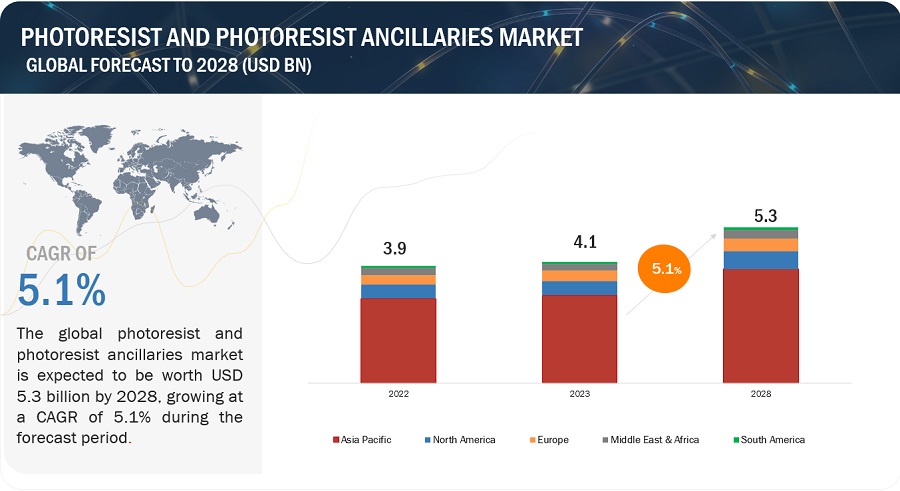
To know about the assumptions considered for the study, Request for Free Sample Report
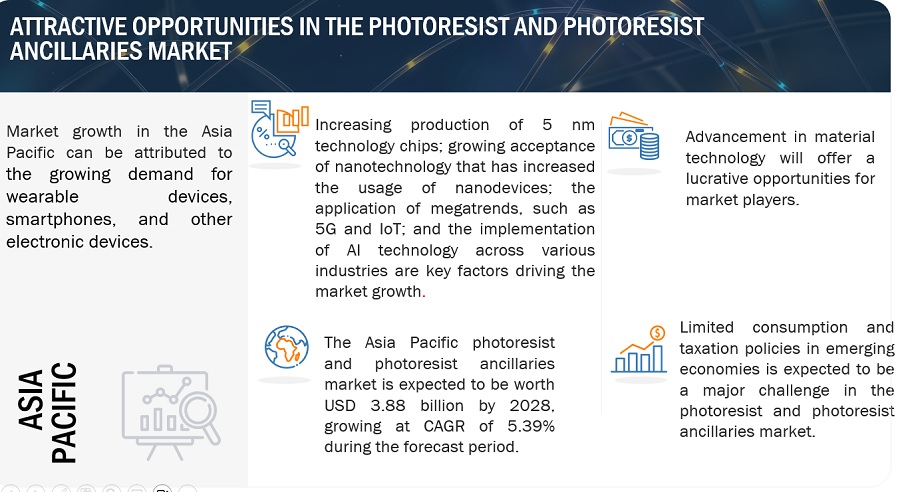
Photoresist and Photoresist Ancillaries Market Dynamics
Driver: Rapidly growing consumer electronics industry to boost growth.
The consumer electronics industry is one of the major application areas of printed circuit boards (PCB)s. The printed circuit board (PCB) is used to mechanically support and interconnect electrical and electronic components using conductive pathways, tracks, or track signals from copper sheets onto non-conductive substrates. The photoresist material is a key material used in the fabrication of PCBs. PCBs are used across various applications including medical devices, LEDs, consumer electronics, industrial equipment, aerospace components, safety and security equipment, telecom equipment, and others.
Restraint: Regulations associated with the environment
Photoresists decompose into low-molecular weight compounds after being exposed to light, including the carrier solvents and phenol, cresol, benzene, toluene, xylene, and other benzene-based aromatic chemicals. Benzene is recognized to have harmful impacts on human health and the environment. The environmental concern about negative impact further leads to imposition of rules and regulations established by bodies such as the EPA and REACH. This environmental concern acts as a major market restraint.
Opportunities: Upcoming technologies such as AI and IoT
The advent of new technologies such as IoT (Internet of Things) and AI (Artificial Intelligence) have created a new product subcategory of intelligent home devices. The use of AI-related technology has opened a myriad of opportunities for electronic materials manufacturers. Technology transitions such as AI and IoT are driving the fast adoption of electronic devices. All these technological advancements require compact PCB designs and hence aid in driving the growth of the photoresist and photoresist ancillaries market.
Challenges : High Cost
The major factor challenging the photoresist and photoresist ancillaries market growth is the cost associated with the photoresist materials in the lithography process. The cost varies as per the complexity of logic in ICs, and the cost depends on the layout along with edge placement error. The layout and edge positioning accuracy affect the pricing. The cost of photoresist is higher since it requires more technology and is harder to use. In certain countries, increasing tax rates also raise the price of photoresist.
Ecosystem
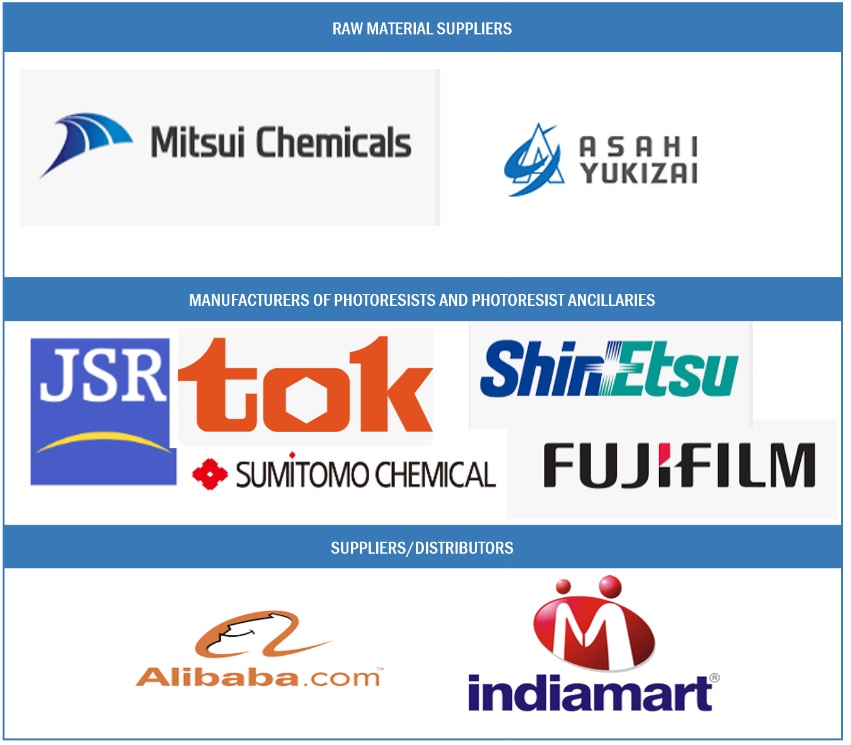
By Photoresist Type, the Arf immersion segment accounted for the largest share during the forecast period
The ArF immersion segment accounted for the largest share in 2022. ArF immersion has the smallest wavelength among all the photoresist types due to which they are suitable for designing small circuits. ArF immersion is used for designing small and more complex circuits. The demand for wearable and small devices is increasing, which is acting as a key driver for the consumption of this type of photoresist. The ArF dry segment is projected to register a CAGR of 5.40% between 2023 and 2028, in terms of value.
By Photoresist Ancillaries Type, the anti-reflective coatings segment accounted for the largest share during the forecast period
Anti-reflective coatings are utilized in the lithography process to improve the photoresist profile and reduce the line width variation caused by scattering and reflecting light. The use of anti-reflective coatings helps improve process operating windows and leads to increased yields while providing cost-effective solutions for advanced semiconductors.
By Application, the semiconductors & ICS segment accounted for the largest share during the forecast period
Semiconductor & ICs is the largest application of photoresist and photoresist ancillaries. Due to the upcoming megatrends, such as 5G, IoT, and AI, the demand for more advance and cutting-edge chips or ICs has increased. This has driven the consumption of photoresist for pattern etching that has led this application segment to acquire a significant share in the photoresist and photoresist ancillaries market.
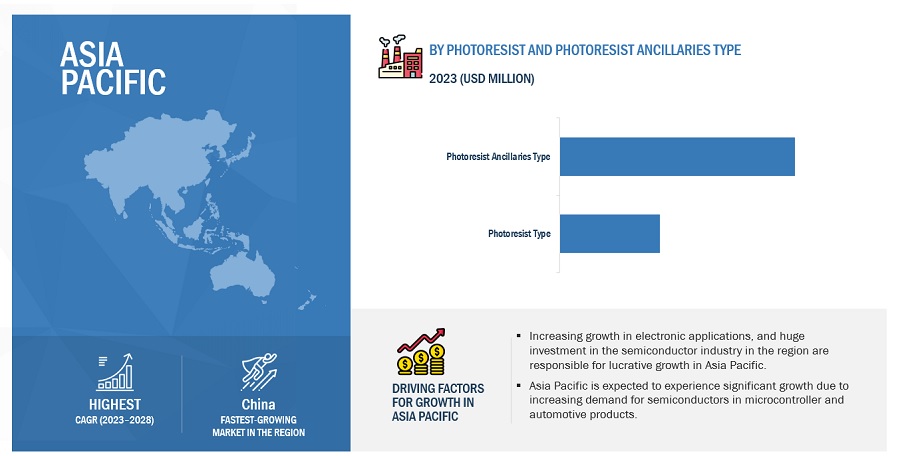
To know about the assumptions considered for the study, download the pdf brochure
China is projected to account for the highest CAGR in Asia Pacific region in the photoresist and photoresist ancillaries market during the forecast period
The Chinese semiconductors market is growing at a higher rate than that of the global market. China is the largest market for semiconductors & ICs globally. It holds a market share of approximately 45% of the demand for silicon chips worldwide. The major application of these chips is in the manufacturing of ICs. Investments from companies, such as Qualcomm and Intel, which are the world’s leading mobile chip and modem manufacturers, will further drive the market in the country.
Key Market Players
Photoresist and photoresist ancillaries comprise of major manufacturers such as JSR Corporation (Japan), Tokyo Ohka Kogyo Co., Ltd. (Japan), Shin-Etsu Chemical Co., Ltd. (Japan), Fujifilm Corporation (Japan), and Sumitomo Chemical Co., Ltd. (Japan) were the leading players in the photoresist and photoresist ancillaries market.
Get online access to the report on the World's First Market Intelligence Cloud
- Easy to Download Historical Data & Forecast Numbers
- Company Analysis Dashboard for high growth potential opportunities
- Research Analyst Access for customization & queries
- Competitor Analysis with Interactive dashboard
- Latest News, Updates & Trend analysis
Request Sample Scope of the Report
:
Get online access to the report on the World's First Market Intelligence Cloud
- Easy to Download Historical Data & Forecast Numbers
- Company Analysis Dashboard for high growth potential opportunities
- Research Analyst Access for customization & queries
- Competitor Analysis with Interactive dashboard
- Latest News, Updates & Trend analysis
|
Report Metric |
Details |
|
Years Considered |
2021–2028 |
|
Base year |
2022 |
|
Forecast period |
2023–2028 |
|
Unit considered |
Value (USD Billion), and Volume (Ton) |
|
Segments |
Photoresist Market By Type, Photoresist Ancillaries Market By Type, By Application, and Region |
|
Regions |
North America, Europe, Asia Pacific, Middle East & Africa, and South America |
|
Companies |
The major players are Tokyo Ohka Kogyo Co., Ltd (Japan), JSR Corporation (Japan), Sumitomo Chemical Co., Ltd. (Japan), Shin-Etsu Chemical Co., Ltd (Japan), Fujifilm Corporation (Japan), and others are covered in the photoresist and photoresist ancillaries market. |
This research report categorizes the global photoresist and photoresist ancillaries market on the basis of Material, End-use industry, and Region.
Photoresist Market, By Type
- ArF Immersion Photoresist
- ArF Dry Photoresist
- KrF Photoresist
- G-line & I-line Photoresist
Photoresist Ancillaries Market: By Type
- Anti-reflective Coatings
- Remover
- Developer
- Others (Primers or Adhesion Promoters and Thinners)
Photoresist and photoresist ancillaries Market, By Region
- North America
- Europe
- Asia Pacific (APAC)
- Middle East & Africa
- South America
The market has been further analyzed for the key countries in each of these regions.
Recent Developments
- In August 2022, JSR Corporation signed an investment agreement for the establishment of a subsidiary in the area of Shanghai. This is done to strengthen JSR Group's business operations in the Chinese market regarding semiconductor materials.
- In September 2021, JSR Corporation launched a subsidiary in Singapore called "JSR Electronic Materials Singapore Pte. Ltd." in order to boost the sales and marketing efforts of the semiconductor materials business in Singapore and Southeast Asia. With the creation of the subsidiary, the company will improve its regional marketing and customer service skills in Southeast Asia, which will result in an increase in the client and product base.
- In October 2020, The Tokyo-based Shin-Etsu Chemical Co., Ltd., announced plans to invest 30 billion yen (USD 280 million) in new facilities at its manufacturing facilities for photoresists in Taiwan and Japan. Shin-Etsu will keep investing in facilities to keep up with the rising demand for photoresists, which are crucial in the production of cutting-edge semiconductors.
- In July 2020, TOK advanced materials have started the production of extreme ultraviolet (EUV) in its facility at Songdo, Incheon, South Korea. The step has been taken to serve Samsung electronics as it has increased the use of EUV-based lithography for chip production.
Frequently Asked Questions (FAQ):
What are the major drivers driving the growth of the Photoresist and photoresist ancillaries Market?
The major drivers influencing the growth of the Photoresist and photoresist ancillaries market are the rapidly growing consumer electronics industry, growth of automotive industries, and the growth in 5G infrastructure
What are the major challenges in the photoresist and photoresist ancillaries Market?
The major challenge in the photoresist and photoresist ancillaries market are the high cost and the constantly changing market dynamics.
What are the restraining factors in the photoresist and photoresist ancillaries Market?
The major restraining factor faced by the photoresist and photoresist ancillaries market is the regulations associated with the environment.
What is the key opportunity in the Photoresist and photoresist ancillaries Market?
Upcoming technologies such as AI and IoT and advancements in technology are the key opportunity for the Photoresist and photoresist ancillaries market.
What are the different photoresist and ancillaries materials used in the Photoresist and photoresist ancillaries?
Arf immersion, Krf, Arf dry, I-Line, G-Line, anti-reflective coatings, removers, developers etc. are some of the materials used in photoresist and photoresist ancillaries market. .
To speak to our analyst for a discussion on the above findings, click Speak to Analyst
This research involved the use of extensive secondary sources and databases, such as Factiva and Bloomberg, to identify and collect information useful for a technical and market-oriented study of the photoresist and photoresist ancillaries market. Primary sources included industry experts from related industries and preferred suppliers, manufacturers, distributors, technologists, standards & certification organizations, and organizations related to all segments of the value chain of this industry. In-depth interviews have been conducted with various primary respondents, such as key industry participants, subject matter experts (SMEs), executives of key companies, and industry consultants, to obtain and verify critical qualitative and quantitative information as well as to assess growth prospects.
Secondary Research
In the secondary research process, various sources such as annual reports, press releases, and investor presentations of companies, white papers, and publications from recognized websites and databases have been referred to for identifying and collecting information. Secondary research has been used to obtain key information about the industry's supply chain, the total pool of key players, market classification and segmentation according to the industry trends to the bottom-most level, regional markets, and key developments from both market-and technology-oriented perspectives.
Primary Research
The photoresist and photoresist ancillaries market comprise of several stakeholders in the supply chain, which include suppliers, processors, and end-product manufacturers. Various primary sources from the supply and demand sides of the markets have been interviewed to obtain qualitative and quantitative information. The primary participants from the demand side include key opinion leaders, executives, vice presidents, and CEOs of companies in the photoresist and photoresist ancillaries market. Primary sources from the supply side include associations and institutions involved in the photoresist and photoresist ancillaries industry, key opinion leaders, and processing players.
Following is the breakdown of primary respondents—
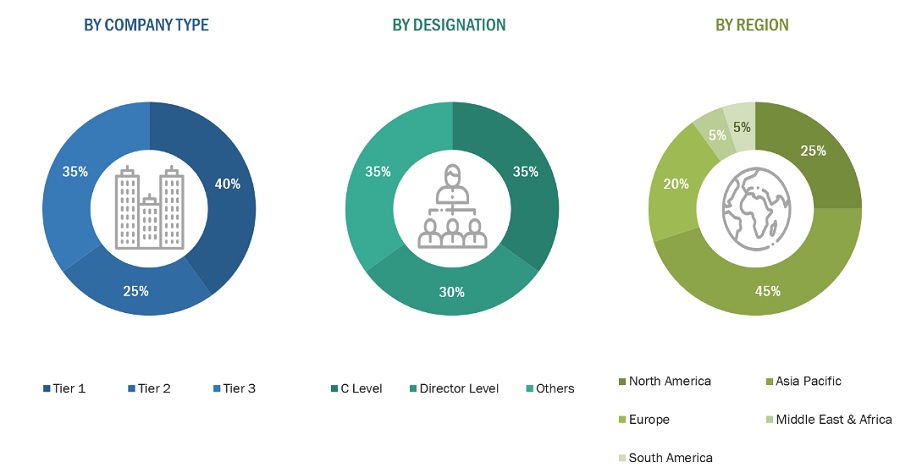
Notes: Other designations include product, sales, and marketing managers.
Tiers of the companies are classified based on their annual revenues as of 2021, Tier 1 = >USD 5 Billion, Tier 2 = USD 1 Billion to USD 5 Billion, and Tier 3= <USD 1 Billion.
To know about the assumptions considered for the study, download the pdf brochure
Market Size Estimation
Both top-down and bottom-up approaches were used to estimate and validate the size of the global photoresist and photoresist ancillaries market. The research methodology used to estimate the market size includes the following:
- The key players in the industry were identified through extensive secondary research.
- The supply chain of the industry and market size, in terms of value, were determined through primary and secondary research.
- All percentage share split, and breakdowns were determined using secondary sources and verified through primary sources.
- All possible parameters that affect the markets covered in this research study were accounted for, viewed in extensive detail, verified through primary research, and analyzed to obtain the final quantitative and qualitative data.
- The research includes the study of reports, reviews, and newsletters of key industry players, along with extensive interviews with key officials, such as directors and marketing executives.
Market Size Estimation: Bottom-Up Approach and Top-Down Approach

To know about the assumptions considered for the study, Request for Free Sample Report

Data Triangulation
After arriving at the total market size from the estimation process explained above, the overall market was split into several segments and subsegments. To complete the overall market size estimation process and arrive at the exact statistics for all segments and subsegments, data triangulation and market breakdown procedures have been employed, wherever applicable. The data have been triangulated by studying various factors and trends from both the demand and supply sides. In addition, the market size has been validated by using both the top-down and bottom-up approaches.
Market Definition
The Photoresist and photoresist ancillaries market refers to the industry that produces and supplies photoresist and photoresist ancillaries materials and products. In order to properly print and etch substrates during the production of integrated circuits and electronic devices, photoresists, which are light-sensitive materials, are utilized in the semiconductor and microelectronics industries. When these materials are exposed to light, a chemical transformation occurs that allows precise pattern transfer. In order to improve the lithographic process, photoresist ancillaries are complimentary materials and chemicals utilized with photoresists. Primer, anti-reflective coatings (ARCs), developers, adhesion promoters, solvents, strippers, and post-processing chemicals are just a few examples of the numerous items available on the market for photoresist ancillaries.
Key Stakeholders
- Raw material suppliers
- Photoresist and photoresist ancillaries material manufacturers
- Government & regulatory bodies
- Research organizations
- Associations and industry bodies
- End users
- Traders and distributors
Report Objectives
- To define, describe, and forecast the global photoresist and photoresist ancillaries market in terms of value and volume.
- To provide insights regarding the significant factors influencing the growth of the market (drivers, restraints, opportunities, and challenges)
- To analyze and forecast the market based photoresist market by type, photoresist ancillaries by type, and application.
- To forecast the market size, in terms of value and volume, with respect to five main regions: North America, Europe, Asia Pacific, Middle East & Africa, and South America.
- To analyze the opportunities in the market for stakeholders and provide details of the competitive landscape.
- To strategically profile key players in the market
- To analyze competitive developments in the market, such as new product launches, capacity expansions, and mergers & acquisitions
- To strategically profile the leading players and comprehensively analyze their key developments in the market.
Available Customizations:
Along with the given market data, MarketsandMarkets offers customizations as per the specific needs of the companies. The following customization options are available for the report:
Product Analysis:
- Product Matrix, which gives a detailed comparison of the product portfolio of each company
Regional Analysis:
- Further breakdown of the Rest of the Asia Pacific photoresist and photoresist ancillaries market
- Further breakdown of the Rest of Europe's photoresist and photoresist ancillaries market
Company Information:
- Detailed analysis and profiling of additional market players (up to 5)












Growth opportunities and latent adjacency in Photoresist & Photoresist Ancillaries Market